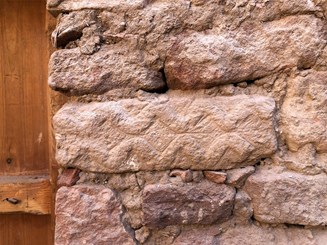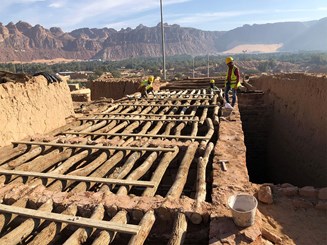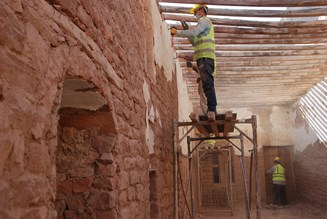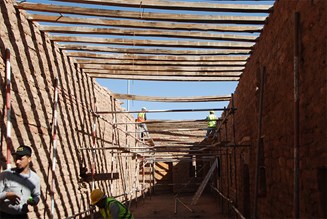AlUla, Saudi Arabia, 18 September 2020: The Royal Commission for AlUla (RCU) today announced it is in the final stages of restoration work on the centuries-old Hamad Bin Yunus and AlZawiyah mosques in AlUla Old Town. For over 800 years a stopping point for pilgrims to Mecca and situated near the ancient earlier spice and incense trade routes, the town was only abandoned in the early 1980s.
Now, AlUla Old Town is undergoing restoration and conservation efforts by RCU as part of a wider effort to share and celebrate its over 200,000 years of human heritage with the world as it prepares to responsibly re-open for tourism next month. This heritage includes the Nabataean tombs of Hegra, Saudi Arabia’s first UNESCO World Heritage inscribed site.
Dr Abdulrahman AlSuhaibani, Consultant for Archaeology and Heritage at RCU, said: “From pre-historic burial sites to the cutting edge Maraya venue, and from pre-Islamic Kingdoms of Dadan and Lihyan to the Islamic Old Town, we’re excited to celebrate and share the cultural oasis that is AlUla with the world. As we explore and make new discoveries across over 22,000km2 of heritage, we’re committed to protecting and preserving AlUla’s incredible human history for the benefit of residents and visitors alike. These two mosques were once vital to their community, and we look forward to them bringing people together once more.”
A return to traditional conservation methods
RCU is committed to working to international best-practice standards in restoration and conservation. It has worked closely with both international experts and AlUla’s community to not only restore the mosques and other sites, but also to understand better the traditional building techniques originally used. Based on archaeological research and conversations with the community, RCU and its partners have been able to carry out the restorations using traditional methods and materials.
In restoring the mosques’ roofs, the restoration team used locally-sourced tamarisk wood joists, which were then layered with palm-leaf branches (jarid) and palm-leaf matting (hassir). The final element of straw and mud bricks on top provides light-weight and historically accurate protection against the elements.
The use of similarly traditional techniques extended to the restoration of the mosques’ walls and floors, from which modern concrete and plaster was carefully removed, allowing the brickwork beneath to be carefully studied. Traditional mud-plaster was then hand applied in age-old fashion by first throwing balls of mud at the walls during shady times of the day to prevent drying, then smoothing down with a wooden flattener.
As Abdulrahman AlImam, an AlUla local and conservation consultant for the project, states, “Natural clay, wood and palm leaves were - and now are again - used in the roofs of buildings in the Old Town. The building materials used are characterised by the unique nature and heritage of AlUla.”
Embracing global standards
This traditionally minded approach is in-line with UNESCO’s conservation principles of authenticity, integrity, reversibility, minimum intervention, and maximum respect for the sites’ historical, symbolic, and aesthetic characters. In addition, the conservation team adhered closely to international conservation charters, in particular the International Council on Monuments and Sites’ (ICOMOS) Mexico Charter on the Built Vernacular Heritage and the ICOMOS Charter of 2003, as well as to standards set by the International Centre for the Study of the Preservation and Restoration of Cultural Property (ICCROM).
Community consultation
In keeping with UNESCO’s principles of community engagement around heritage sites, RCU is also working closely with the community on understanding and conserving the Old Town and its mosques. The community had been responsible for maintaining the mosques and other buildings for generations. Members of the community, some of them children and grandchildren of former residents, such as Abdulrahman AlImam, joined the international experts to lend their own knowledge and deep interest in revitalising the Old Town. Indeed, recording oral histories of the Old Town from AlUla’s community has been vital to building up a better understanding of its history and role in wider Saudi and Islamic society.
The Hamad Bin Yunus and AlZawiyah mosques are both located in the AlHalaf neighbourhood south of the Mussa Bin Nussair citadel and reflect AlUla’s history as an important stopping point on pilgrimages to Mecca and Medina. The Hamad Bin Yunus mosque dates from the 8th century AH (14th century CE), while the dates of AlZawiyah mosque’s original construction are still being investigated.
RCU is actively collaborating with The Program for the Reconstruction of Historical Mosques, adopted by the Saudi Ministry of Tourism and with the partnership of the Ministry of Islamic Affairs, to ensure the mosques’ religious roles are fully respected. Both mosques have undergone a series of restorations in their history, the most recent occurring in 1373 AH (between 1953 and 1954 CE), during the reign of his late Majesty King Saud.
Mohsen AlQarni, Director of the Programme for the Reconstruction of Historical Mosques, said: “The restoration of the Hamad Bin Yunus and AlZawiyah mosques in the Old Town comes within the framework of the Historic Mosques Restoration Programme, which aims to preserve historical mosques all around the Kingdom.”
The living museum
RCU’s mosque conservation programme is part of its commitment to protecting, preserving, sharing, and celebrating AlUla’s heritage as it establishes AlUla as a living museum, at the forefront of Saudi Arabia’s cultural, historic, and natural tourism sectors.
This programme and others are running in parallel with efforts to develop new hotels and other tourism infrastructure that stands in harmony with AlUla’s cultural landscape. This coming together of history and modernity will create authentic experiences for visitors as they journey through time from the award winning 21st century architecture of Maraya to the architecture of centuries and millennia before it.
RCU’s vision to establish AlUla as a global destination for cultural, historic, and eco-tourism will also elevate the quality of life for the region’s communities through new economic opportunities, in-line with Saudi Arabia’s ambitious Vision 2030 programme. This development is guided by 12 strategic principles drawn from RCU’s Framework Plan and Charter ensuring all development is sustainable and supports RCU’s Cultural Manifesto for AlUla.
 |
 |
| Reuse of an older carved block in the Hamad Bin Yunus Mosque | Repairing the roof of Hamad Bin Yunus Mosque using tamarisk wood beams. |
 |
 |
| Interior recovery to the AlZawiyah mosque | Roof restoration to AlZawiyah mosque |